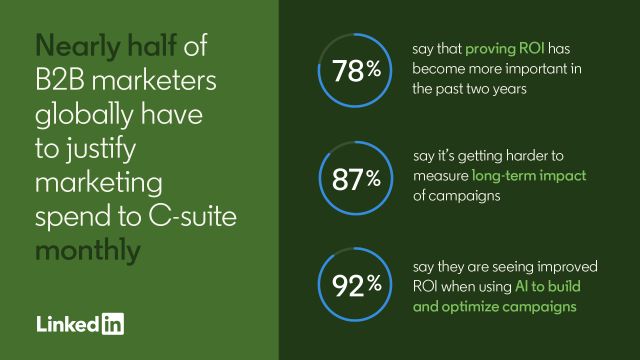A new study highlights growing pressure on B2B marketers to demonstrate return on investment (ROI) as buying cycles lengthen, prompting LinkedIn to expand its measurement tools. The professional networking platform announced enhancements to its Conversions API and Revenue Attribution Report (RAR) to help marketers link their efforts to business outcomes more effectively.
Mounting Pressure to Justify Marketing Spend
According to LinkedIn’s latest ‘B2B ROI Impact’ study, which surveyed over 1,000 B2B marketers across the US, UK, France, and India, nearly half (46%) of respondents report monthly justifications of marketing spend to C-suite executives. Additionally, 87% say measuring the long-term impact of campaigns has become increasingly difficult.
These findings come at a time when 78% of B2B CMOs report that proving campaign ROI has become more critical over the past two years. As businesses tighten budgets and demand clearer results, marketers face growing scrutiny to demonstrate their contributions to revenue.

A Shift Toward Value-Based Metrics
Despite senior leadership’s emphasis on traditional volume-based metrics such as Return on Ad Spend (RoAS) and Customer Acquisition Cost (CAC), B2B marketers are prioritizing value-based indicators like Marketing Qualified Leads (MQLs) and Sales Qualified Leads (SQLs). While 40% of senior leaders focus on RoAS, marketers argue that tracking qualified leads provides a clearer picture of future revenue impact.
This shift signals an evolving mindset in B2B marketing, where long-term value and buyer intent are gaining prominence over short-term cost-efficiency metrics.
Adapting Strategies Amid Changing Buyer Behavior
With buyer intent becoming harder to gauge, nearly half of B2B marketers (46%) are shifting to a buyer group marketing strategy to drive conversions, while 45% are prioritizing Customer Lifetime Value (CLV) in their reporting. This pivot reflects the challenges of navigating longer sales cycles and the increasing need for precise targeting.
AI’s Role in B2B Marketing Measurement
Artificial intelligence (AI) is emerging as a crucial tool in addressing these challenges. According to LinkedIn’s study, 92% of B2B marketers believe AI will positively impact measurement over the next five years. Already, 90% report improved ROI from AI-driven campaign optimization.
Marketers are leveraging AI to:
- Enhance audience segmentation and targeting (57%)
- Conduct predictive analysis for performance improvement and lead scoring (55%)
- Automate routine tasks (53%)
- Optimize ad spend and creative content in real time (53%)
LinkedIn’s Expanding Measurement Capabilities
In response to these trends, LinkedIn is investing in tools designed to provide clearer attribution of marketing efforts to business outcomes. Its enhanced Conversions API allows for more accurate tracking of customer actions, while the Revenue Attribution Report (RAR) helps connect LinkedIn marketing activities to revenue impact.
For B2B marketers, these developments could offer a more effective way to demonstrate value and secure future budgets. As marketing teams continue to navigate shifting expectations, AI and improved measurement tools may play a crucial role in bridging the gap between marketing initiatives and executive decision-making.

